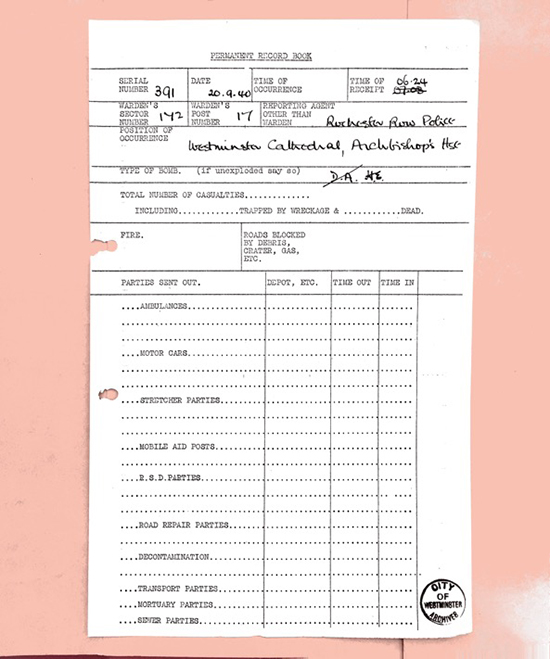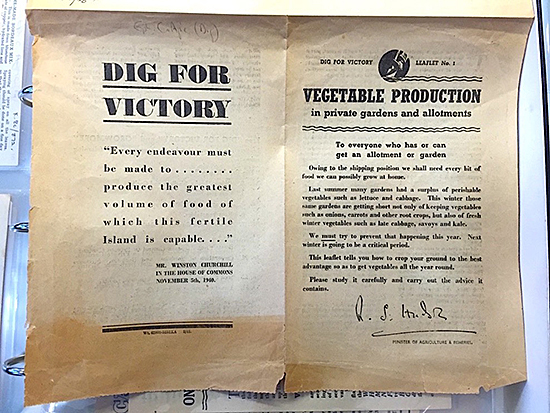October 22, 2016
Ecologies of resilience: Westminster’s
bomb crater garden and the
Dig for Victory campaign
War is the normal occupation of man — war and gardening
— Winston Churchill
Written by Adam Przywara
Terror & Morale
When did the Second World War start? The answer to this seemingly simple question presents several problems of a historical and philosophical nature. One could list the dates, produce the documents and photographs which would prove with certainty that in a particular month, day and even a particular hour in 1939 this conflict became officially explicit. On the other hand, with the same certainty, one could show that World War II was just the culmination of tendencies that had been unfolding throughout 19th century. The deadly socio-political tendencies which first erupted in the Great War, had their culmination in the horrors of the 1940s. Another theory, potentially the most dubious, could be that the war never started and it never ended. It is just lurking as a shadow incorporated into the power structures of modern societies. This potentiality was cultivated constantly as a strategy of politics in times of peace. And precisely in this historically determined period that this potentiality found means of self-realisation. The repressed desire of the democratic state as a power-projecting machine became clearly visible. Let us repeat the question — when did the Second World War start?
The answer to this question requires to be firmly situated in time and space. The Second World War in Great Britain, specifically in the capital, London, did not start with the official declaration of war on 3 September 1939. People living in the capital felt the pressure of the coming events months and years before that date.[1] There was no time for them to forget the struggles of the Great War which had ended just 20 years before. The memory of food scarcity and the isolation of the British isles was permanently lodged in the social memory. But apart from that, changes in modern warfare diminished the belief that the British home front was something geographically inaccessible. The zeppelin air raids of 1915, which killed over 1500 people,[2] comprise the second mass memory of the previous war. Accordingly, since the problem of starvation could be managed quickly in the time of peace with imperial power dispersed over the whole Commonwealth, the intersubjective fear of attack from the sky remained strong, and was further fuelled by such events as Spanish Civil War. The psychological effect of these events was tremendous — on the eve of WWII, the British nation was falling into the realm of hysteria and panic.[3]
The modern war of the 20th century began with a widespread and overwhelming terror at the realities of invasion and the prospect of countries meeting the same fate. In the case of Great Britain it was preceded by long and tiring days of anticipation and preparations, popularly known as the Phoney War. The political groundwork was officially laid with the Power (Defence) Act passed on 24 August 1939. The second version was passed on 22 May 1940, and was accompanied by Winston Churchill’s assumption of the prime ministership. And even after the German attack on France in May, the British home front did not seem to be in danger. The stress and constant false alarms led to the situation in which approximately half of British society was sure that there would be no raids on London. Furthermore, constant black-outs, and the introduction of food rationing significantly undermined civilian morale.[4] The government became more and more aware that this conflict would have to be planned, not only on the distant front lines, but chiefly on the island of Great Britain itself.
When Germany went to war against Britain the Germans’ primary aim was to reach an agreement with the British, and then the Germans changed their tactics towards forcing a British surrender.[5] Hitler’s army was not capable of launching the invasion with any certainty of success. However the Germans did apply the tactics of psychological warfare, pressuring the population to urge the government to negotiate. As in WWI, immediately after the declaration of war, German submarines and ships started to destroy naval food transports coming into the UK. The tactic was old and predictable, but it was also easy to carry out and extremely effective. Great Britain, being a global empire, imported cheap food into the country, and it took the source for granted since all the markets flourished in time of peace. Great Britain relied on the other countries of Commonwealth to such an extent that, for example, imported cereal products comprised 88% of total consumption.[6] The lack of nutritional self-sufficiency became the main point of the Nazi pressure. It ideally suited the strategy of psychological terror previously used by Hitler on continental Europe. The Second World War appeared as a war of morale and nutrition, and in this it strongly resembled the premodern devastating wars of sovereigns.
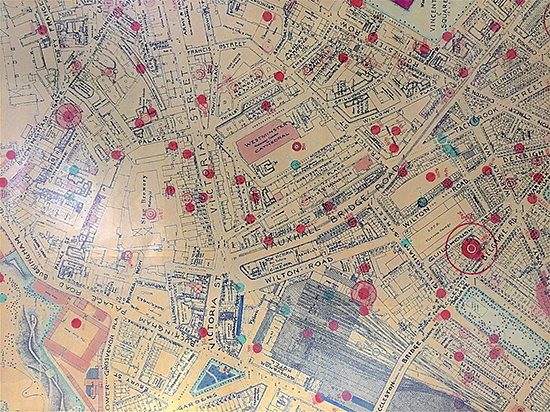
The supposedly never-ending political tensions accelerated quickly into the Battle of Britain, and then into the devastating horror of the air raids during the autumn months of 1940. The population, which started to be assured of its safety overnight, became the main target of the whole Luftwaffe fleet. The bombs started to fall heavily from the sky over London and over the whole of Britain. In the capital, the reign of terror began in the first days of September and lasted for the next months. Death revealed itself as something permanent and slipped into the everyday existence of the British society. The terror of air raids was unpredictable and unstoppable, with neither political nor military means of defence. The government could try to fight against it and focus on documenting the effects of the bombing (fig.1) and converting it into statistical terms.[7] This was the point when the real war in Britain started. The terror dominated the everyday life of the whole population. No one was safe, and the deeply repressed fears of the bombings revealed themselves. Throughout this period in London 15,775 people were killed and 1,400,000, or one in six, were rendered homeless.[8] The habitus of the nation became alienated, dwellings collapsed into piles of rubble, and the environment fell prey to the realm of terror. "You take my life/When you do take the means whereby I live” - that is how Shakespeare characterised the process which seems appropriate to represent the radical dissolution of subjects and the environment at the time of the Blitz.[9]
The bombings, and mobilisation of society faced with war, fast become constituted as the historical symbols of the people’s resilience and government’s resistance. However, beneath this mythologizing discourse, we will find the material traces of specific political actions belonging to the particular describable actors. These material traces shed a light on complex processes which were enacted throughout the time of emergency in Britain. The war of morals, and the emergence of terror, made the ”home front” the space of the strongest experimentations in the fields of affect management, biopolitics, and sustainability. Simultaneously, the constant oppression falling from the sky over Britain was the ultimate stimulus for collective action and co-operation. All these processes emerged as manifold and complex, thus contradicting the unified historical image of the war effort. Their realisation presented the hugely successful power structure creating strong relations between the state, individuals, and other actors. This structure, which could be called the ”Ecology of Resilience”, fell into oblivion shortly after the end of the official conflict.
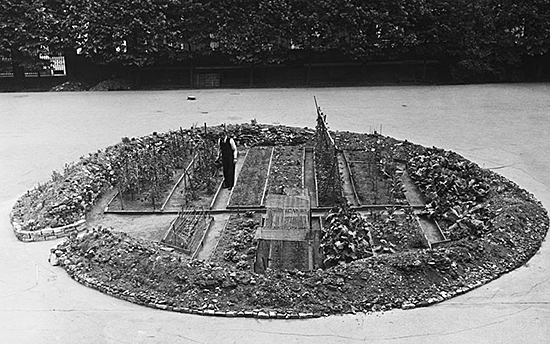
Explication & Dwelling
The disease bringing rubble and death spread quickly around London. It attacked not only the skin of the city, covering it with red spots, but also the mind of its population. The state of emergency became real and the time of survival commenced. The government and media responded quickly and decisively. The catastrophes were documented, and categories specially issued for this purpose (fig.3). Bombs were given serial numbers and descriptions. They had to be named in the official discourse, the people affected by them had to see that the institutions were working. In the middle of the map (Fig.1) one can see the small dot with number 391. This was a relatively early bomb — it fell on 20 September 1940. German airmen aimed for Westminster Cathedral, as they did with other churches in the city.[10] The bomb missed the target, and did not explode immediately.[11] From the map and bomb record we can assume that it fell, stuck in the ground, and exploded minutes later, creating a round crater in the square between the choir of the cathedral and Morphet Terrace. In this hardscape of empty plaza, where nothing had happened for at least two hundred years,[12] the bomb became a peculiar dialectical actor. It spread terror, but simultaneously it explicated a long forgotten possibility: the possibility of a garden.
The crater was left intact until the following spring with the beginnings of the possibility of cultivation. It took two years from the bombing to foster the garden which is shown in the photograph (fig.2) and film stills (figs. 4-5). Both visual sources were used in the broad public agitation correlated to the ”Dig for Victory” movement. The photograph was taken by a news reporter, Harry Shepherd, who documented the life of the British population during wartime. The film still is taken from a short news reel produced by British Pathé. The film documentary is one of many, showing the carefully selected war effort symbols, highlighting, among others, kids working in gardens established in the ruins and a blind gardener cultivating his crops. Visually powerful, the bomb crater garden images were intended to represent the resilience of Londoners. However celebrated, paradoxically, the history of the site was not documented adequately, and it functioned since this time as an empty symbolic image without historical denotation.

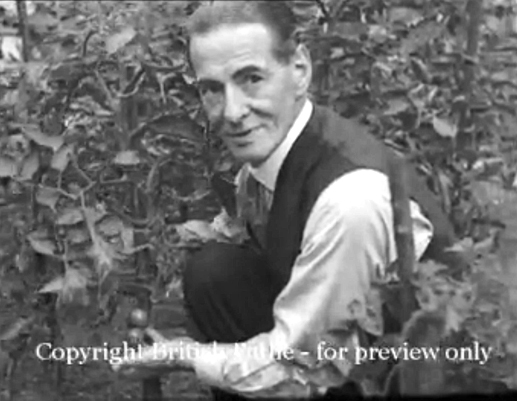
The peak of the Dig for Victory mobilisation was determined by several historical factors. Food rationing became stricter after spring 1940, and the government relaunched the propaganda materials, after its predecessor, the ”Grow More” action, did not fulfil the expectations. The movement gained in momentum and the number of cultivated allotments peaked. The creation of the bomb crater garden should be correlated with both. From the description in the Getty Images archive we are informed that it shows: „A gardener in the grounds of Westminster Cathedral watering vegetables in a plot formed from a bomb crater left after a German air raid on London, 14th July 1942. After the raid, the cathedral caretaker left the crater largely intact, ringing it with bricks and preparing the soil for tomatoes, peas, lettuces, cabbage and other crops."[13]From the British Pathé material we are also informed that the caretaker’s name is Mr. Hayes and „what was once the bomb was transformed [by him into] boom”.[14] There is also another photo of the garden which shows that Mr. Hayes, while working, had possibly the help of his wife and daughter.[15] Propaganda materials and strict food rationing were the primary stimuli for Mr. Hayes’ thoughts about the potential garden. He did not receive off-ration meals, which was privilege of hard labourers, and probably his wage did not increase during the war which undoubtedly made his life harder.[16] As a person from the working class, Mr. Hayes had to be familiar with the allotment work. As a caretaker of Westminster Cathedral, he would have seen crater number 391 everyday, which he certainly would have related to the horrors of recent air raids. It is also possible that he was familiar with many other churchyards around London, and the wasteful hardscape of the square became unacceptable to him. This affective radiation from the excavated soil and explicated potentiality, together with a subjectivity wounded by the terror of air raids, provided the impulse needed to start the process of tending and nurturing.
The cultivation of land inside the city itself presented several disadvantages which had to be overcome. The bombings made explicit the possibility, but the soil which had spent years under the pavements, buildings, and squares was not fertile enough to instantly produce the needed nutrition. Simultaneously, the knowledge of land cultivation had been generally forgotten in times of peace and market reality. The old patterns of land use had to be re-established and learned once more. Mr. Hayes certainly faced the same problems as the whole urban population — the lack of manure and the need for fertile soil. The government strategy for food production at the time of war minimised the amount of fodder produced which automatically made animal manure scarce. The subsidised artificial fertiliser was introduced in the fourth year of war.[17] But the urban collectives discovered several different ways to negotiate relations with the soil in times of crisis. Manure became the actor of national importance. Horse dung was either lacking or priced too high, which caused an increase in the usage of small animal excrements, such as pigs and rabbits. In the industrial cities of North England the wool wastes from army uniforms were used. And in London, pigeons unexpectedly became an important part of the war effort: ”In Kensington, West London, 10 tons of pigeon manure were scraped from the inside of roof of St John the Baptist Church and distributed to the allotment-holders in the borough”.[18] Later in the war, the commonly introduced compost heaps helped to keep the ground fertile and stood as reminders of the zero organic waste policy of the time.
Mr. Hayes surrounded the hole in the ground with rubble and bricks. He fertilized the soil, and started the process of cultivation. The garden had its utility, but it also had an aesthetic appeal which complied with the strong symbolic value of the whole formation. The vegetables were placed in rows clearly inspired by the Dig for Victory leaflets to intensify the production and to make it last for a whole year. The visible aim of the garden was to recompense the shortages of vitamins in the war-time diet and to make it more diverse.[19] However, what stands out in this particular allotment like garden is a line of flowers enveloping the crater. It comprises the aesthetic gesture of non-productivity together with the nutritional and pragmatic cultivation of vegetables. Underneath the sphere of social mobilization, Dig for Victory propaganda materials, media coverage and food rationalization, we can observe the originality of an individual gesture of resilience which deviates from the norms imposed on the population by the government.[20] Mr. Hayes not only had to compensate of the lack of nutrition in his and his family diet; after the horrors of the Blitz he had to find a way to re-dwell in this traumatic reality. And Hayes’ aesthetic and productive gesture completely fulfils it, concentrating in itself both meanings originating in the Germanic etymology of the word ”dwelling” — cultivation and construction.[21] The garden constitutes the sphere of tending within a reality which emanates from the destructive power of terror. The garden on its own becomes the collective action of resilience, both providing nutrition and vitamins for the family, and aiding the immense need for psychological recovery after surviving months of air raids.

State & Body Nutrition
Additional pressure on the British administration on the eve of war was unquestionably furthered by the memory of the last 30 years upon which were based predictions of what could appear on the historical horizon. In the First World War, when Germany used U-boats to destroy food transports, mobilisation around the country was not sufficient enough. It ended with the malnutrition of the great majority of the population and great loses in the labour power. Moreover, for less than 20 years of peace, the country went through the agricultural depression of 1930s, which did not make things better. Country’s nutrition supplies were based strictly on imports, agriculture technologies were old and inadequate, and the anticipation of war destroyed the morale of workers. However, certain things have changed, especially in the realm of the scientific knowledge of the human body. Since the Great War, the League of Nations emphasised the huge importance of nutrition in providing well-being to the population. The scarcity of nutrients became the object of study and measurements, with general calorific balances being established.[22] The second war broke out at the same time when major reports on the subject were being issued. In Britain, the most important report was presented in 1937 under the name ”Food, Health and Income”.[23]
It showed that market developments and the accelerating exploitation of workers completely neglected the subject of proper nutrition for the working classes. This was at once a threat and a challenge for the administration — the state of emergency allowed for the possibility of exercising an inclusive nutrition policy represented by the words: „everyone, without regard to income, should be supplied with food according to his or her physiological need."[24]
At the administrative level, the project of population resilience was twofold — on the one hand, it mobilized the collective, on the other hand, it provided for the collective in the most intensive way. In this dialectical relation, a surplus of food and affects was produced which we should now examine more closely. In 1938, even before the official declaration of war and attacks on the food transports, printers were issuing rationing cards for the whole population — these were the first sign of a system which was to be implemented a couple of years later. Simultaneously, the Ministry of Food was established, which during the war became a monopolist on the food market, strictly controlling all flows of nutrition around the island. Lord Walton, the head of the Ministry, appointed Jack Drummond as his scientific advisor — these two actors would develop the whole British policy implemented in the first years of the war. The main objectives of the government were established: 1. Rationalize the food imports affected by German attacks on food transport; 2. Produce more food within Britain 3. The control of distribution at regional and personal levels 4. Calculate and provide adequate nutrition for the whole population.[25] Giving the argument I am perusing in this paper we will look mainly at second and fourth of these objectives.
The project of producing the highest possible volume of food from British soil was twofold. It was the objective of both the ”Dig for Victory” action, which operated on the level of population as a collective of individual bodies; and the intensification of agricultural production and artificial food enrichment at the level of the state as a network of institutions and technologies. Fig.5 and 6 show the first edition of the leaflet distributed by the Ministry of Agriculture at the beginning of the first objective. ”Dig for Victory” was predominantly aimed at mobilising and educating the whole population to make it self-sufficient and immune to malnutrition. In the first months of the war, this action was not really successful. Only after the bombings and the beginnings of rationing did it succeed in pulling the public together as a ”confederation of bodies living through same harm and problem."[26] The war-time allotments were distributed by the government as land requisition made possible through introduction of the emergency laws. The ambition was to provide one allotment for every five households. This figure was sometimes greatly exceeded — mainly in the endangered cities. The common movement flourished, and about 1.3 million tonnes of food was produced from 1.4 million plots.[27] There were eventually 26 Dig for Victory leaflets printed, covering everything from planning your crops, digging, sowing, dealing with pests and diseases, storing, and making preserves.[28] This knowledge still existed amongst parts of working class and rural society, but now it had to be disseminated to the whole population. The leaflets were supported by highly sophisticated imaginaries of propaganda posters prepared mainly by Abraham Games between 1941 and 1946. The action diversified the nutrition sources, provided a needed boost of work and mobilization in a population torn by strong affects towards a government and the war. It became a symbolic and practical fundament of the management of living in times of crisis.
The other side of the ”Dig for Victory” coin was the industrialization and intensification of food production around the country and the rationalization of food distribution. The aim which Winston Churchill had made explicit on the leaflet (fig. 6) was realised mainly in this less promoted part of food production. And the Women’s Land Army had a great part in this success. At a time when men were fighting at the front, this organization took on the whole agricultural industry. Production was developed to maximize food supply and maintain the energy of society at the appropriate levels.[29] It worked: the internal production of wheat and potatoes almost doubled from 1939 to 1942. Meat production decreased, but protein intake was still maintained at acceptable levels. The avant-garde project of food enrichment started in 1941 when the first signs of lack in diet appeared. Flour was enriched with calcium, thiamine, niacin, iron, margarine with Vitamin D and A. The lack of the latter was also addressed by the ”Dig for Victory action”, where the cultivation and consumption of carrots was intended to balance the lack of imported exotic fruit. But the real power of the state, driven by the life preserving objectives, appeared in the second stage of this war-time division of labour — in the distribution part. Fig. 8 shows the publication of Ministry of Food which provides us with all the detailed information in this area. In 1939, National Registration was conducted, gathering data about the whole population. Based on the returns, ration books were issued in three types.[30] The rationing system in Britain was flexible and wholly dependent on the amounts of food controlled by Ministry of Food. The additional schemes which supported the social augmentation off-rationing were the famous British Restaurants, Factory canteens and emergency feeding schemes.[31] The success of the system was confirmed by surveys: ”Details of food purchase during week were collected from 600-700 working-class households every month, and from these the nutrients available to the household were calculated. The results show that on the whole the diet was up to requirements, except in vitamin A. Similar surveys of middle-class households showed that there was little difference between their diet and that of the working class households, reflecting the general levelling out of food distribution during the war."[32]
And as shown earlier, in addition to this general supply, the greater percentage of the population could provide even more food from their allotments. The nutrition scarcity which troubled Britain in the times of peace, becomes resolved in the time of war.
Apart from the whole military discourse, the nutrition policies of Great Britain after the end of war were broadly recognised as having succeeded.[33] The resilience of the population in the sphere of biology and morale was supported by the government with maximum efficiency and understanding. What is most striking is that the total calorie value of the diet „fell from the pre-war level of 3,008 per head per day to little more than 2,800 in 1940-1941, but was restored to its prewar level in 1944” — however, this time it was restored within the population as a whole, and not just for certain classes. The scientific knowledge concerning nutrition and energy production in the human body provided the basis for the first governmental nutrition indications on such a scale. The strong biopolitical bond was established between the state and the collectives. The geographical situation of the country made it possible to strictly separate the death-reality of soldiers and lifereality of the home front. The emergency state provided the possibility of nurturing life on the scale impossible to achieve in times of peace. The population submitted itself to this power relation and benefited from it by gaining the needed minimum of nutrition — rationing — and by the means to provide for itself — ”Dig for Victory action”. The oppression of the totalitarian state finds its contradiction in the Democracy within which the network of ecological and economic relations between the soil, subjects, and institutions are willingly created.

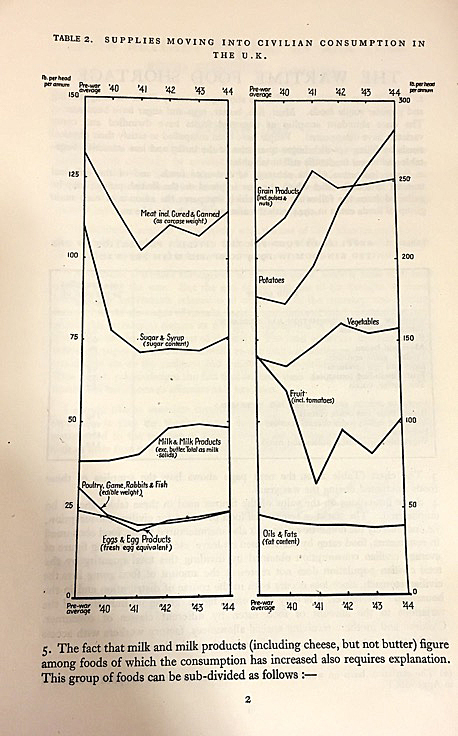
Conclusion: Scale & Autonomy
At 8:30 we heard a most terrific explosion and the sound of everything falling. Dirt and rubble trapped us in the shelter. … With the help of our neighbours we negated to make a hole big enough to crawl through. I shall always remember what I saw then: Just a pile of rubble where our bungalow had stood. Besides us was large gaping hole. I had planted rows of spinach in the garden. Not a bit remained. An apple and a pear tree had completely disappeared. … Human nature is a funny thing for, believe it or not, although we had lost everything we possessed, the thing I mourned for most was my precious spinach.[34]
This wartime memory of Grace Foakes shows us all the scale and relations established at the level of the state and the individual in Second World War Britain. It shows us how a population of a state targeted by war becomes shattered into individualized subjects facing the terror of an air raid. And is shows us also how affective bonds are established between these subjects and their environment. The war was an intersubjective experience of a whole population and we can presume that Foakes’s experience is to some extent similar to those lived through by Mr Hayes. Plants had become the important actors of their everyday life, as they became for society as a whole. They started to exist as a part of the resilience structure at both the individual and collective scale. This leads us back to the garden cultivated in bomb crater 391 near Westminster Cathedral.
The self-sufficiency of the whole country could not be achieved without the mobilization of both its substrate — population and the government. ”Dig for Victory” action and the scientific management of nutrition together formed a base for one of the most positive processes in the history of World War II. The valuable qualities of this mode of resilience can appear to us now in their fullest. Mr Hayes, in cultivating a garden in the bomb crater, did not just create the means of subsistence for him and his family in times of their scarcity. The nutritional value was provided by the state in acceptable amounts and volumes. Rather, he established an autonomous space of resilience, a collective of humans and non-humans, which gave him the ability to survive the war and to produce those affective qualities which were lacking in his contemporary reality. He turned to cultivation as a means of appropriation and re-dwelling in a space which was taken from him in the course of terror. This practice of tending provided temporal and spatial qualities which helped in effectively confronting the crisis without denying or repressing it. Stimulated by the governmental propaganda and his own experience, Mr Hayes reconfigured his individual relations to the environment and its main actors. He established a self-supporting structure which was neither something utopian nor fantastic, but exactly the opposite — it was mundane and bodily based, and this constituted its power.
On the opposite side of the established power structure, the government reconfigured its approach, which in time of peace was strictly driven by the capitalistic economy. It used the data submitted by society, and the knowledge provided by science, to establish the inclusive policy of nutrition. The aim, which before the war seemed idealistic, became overnight the fundament of state persistence. But what is even more important, the British administration realised that the need for mobilization could not be based in discourse alone - it had to be supported by action. The freedom to act itself produces an important affect, namely the individual choice of whether or not to take part in the action.[35] These several observations foreshadowed the path towards the positive biopolitics which is focused on supporting the whole human collective as a species-being, while at the same time it grants individual subjects a high degree of self-determination. The paradox is that in the state of emergency the population is driven by an ecology of resilience, whereas in the time of peace the market economy of survival is a driving force. Accordingly, the nightmare of food scarcity and malnutrition showed itself exactly after the transition into the post-war period.
[1] Tom Harrisson and Madge Charles, War Begins At Home (London: Chatto & Windus, 1940), 3.
[2] Ursula Buchan, A Green And Pleasent Land (London: Hutchinson London, 2013), 25.
[3] Ursula Buchan, op.cit, 28.
[4] Tom Harrisson and Madge Charles, op.cit, 184.
[5] John Keegan, The Second World War (New York: Viking, 1990), chapter 4.
[6] Ministry of Food, How Britain Was Fed In War Time; Food Control 1939-1945 (London, 1946), 7.
[7] Michel Foucault, Society Must Be Defended (New York: Picador, 2003), 244.
[8] Amy Helen Bell, London Was Ours (London: I.B. Tauris, 2008), 8.
[9] Peter Sloterdijk, Terror From The Air (Los Angeles: Semiotext(e) 2009), 15.
[10] See: Gordon Huelin, Vanished Churches Of The City Of London (London: Guildhall Library Pub 1996).
[11] The delayed explosion is stated on the map(fig.1) and in the permanent record book(fig.4)
[12] Simon Bradley and Nikolaus Pevsner, London 6: Westminster (New Haven, CT: Yale University Press 2003), 673.
[13] ”A Gardener In The Grounds Of Westminster Cathedral Watering,” Getty Images, accessed 21.04.2016, http:// www.gettyimages.co.uk/detail/news-photo/gardener-in-the-grounds-of-westminster-cathedral-watering-news-photo/ 106567894.
[14] "Gardens Aka Bomb Crater, Blitzed Gardens,” British Pathé, accessed 17.04.2016, http://www.britishpathe.com/ video/gardens-aka-bomb-crater-blitzed-gardens-issue.
[15] "Victory Gardens. Where The Nazi's Sowed Death, A Londoner And His Wife Have Sown Life-Giving Vegetables In A London Bomb Crater. Official British Photo. National Archives Catalog, accessed 17.04.2016, https:// catalog.archives.gov/id/196480.
[16] Information concerning both subject can be found in: Ministry of Food, How Britain Was Fed In War Time; Food Control 1939-1945 (London, 1946).
[17] Twigs Way, The Wartime Garden (Oxford: Shire publications, 2015) 15.
[18] Twigs Way and Mike Brown, Digging For Victory (Sevenoaks: Sabrestorm Pub 2010), 98.
[19] Ministry of Food, op.cit, 48.
[20] On norms see: Michel Foucault, Society Must Be Defended, 249.
[21] Martin Heidegger, Building, Dwelling, Thinking, in: Martin Heidegger, ”Basic Writings” (New York: Harper & Row 1977), 243.
[22] Frank Boudreau, “Nutrition in War and Peace”, The Milbank Quarterly 83, no. 4 (2005): [Wiley, Milbank Memorial Fund]: 609–23, accessed 17.04.2016, http://www.jstor.org/stable/30045635, 610.
[23] Frank Boudreau, op.cit. 613.
[23] Ibid, 614.
[24] Ibid, 614.
[25] Jane Bennett, Vibrant Matter (Durham: Duke University Press, 2010), 102.
[26] Helen Lightowler, “Nutrition, Food Rationing and Home Production in the UK During the Second World War,” in: Food in Zones of Conflict: Cross-disciplinary Perspectives, ed. by Helen Macbeth, Paul Collinson, (New York:Berghahn Books, 2014), 109.
[27] Twigs Way, The Wartime Garden (Oxford: Shire publications, 2015), 13.
[28] Nutritional research made in the period between the wars provide a knowledge to the government what amounts of nutrients people have to be provided with.
[29] Ministry of Food, op.cit, Appendix D.
[30] Ibid, 44.
[31] Ibid, 49.
[32] Helen Lightowler, op.cit, 119.
[33] Grace Foakes, My Life With Reuben (London: Shepheard-Walwyn, 1975), 66.
[34] Tom Harrisson and Madge Charles, War Begins At Home, 413.
References
Bell, Amy Helen. 2008. London Was Ours. London: I.B. Tauris.
Bennett, Jane. 2010. Vibrant Matter. Durham: Duke University Press.
Boudreau, Frank G. 2005. "Nutrition In War And Peace". Milbank Quarterly 83 (4): 609-623. doi:10.1111/j.
1468-0009.2005.00394.x.
Bradley, Simon, and Nikolaus Pevsner. 2003. London 6: Westminster, New Haven, CT: Yale University Press.
Buchan, Ursula. 2013. A Green And Pleasent Land. London: Hutchinson London.
Collinson, Paul, and Helen Macbeth, eds.. 2014. Food in Zones of Conflict: Cross-disciplinary Perspectives.
1st ed. New York: Berghahn Books.
Foakes, Grace. 1975. My Life With Reuben. London: Shepheard-Walwyn.
Foucault, Michel, Mauro Bertani, Alessandro Fontana, François Ewald, and David Macey. 2003. Society Must Be Defended. New York: Picador.
Grayzel, Susan R. 2012. At Home And Under Fire. New York: Cambridge University Press.
Harrison, Mark. 1998. The Economics Of World War II. Cambridge: Cambridge University Press.
Harrisson, Tom, and Charles Madge. 1940. War Begins At Home. London: Chatto & Windus.
Heidegger, Martin. 1977. Basic Writings. New York: Harper & Row.
Keegan, John. 1990. The Second World War. New York: Viking.
Sebald, W. G. 2003. On The Natural History Of Destruction. New York: Random House.
Sloterdijk, Peter, Amy Patton, and Steve Corcoran. 2009. Terror From The Air. Los Angeles: Semiotext(e).
Way, Twigs. The Wartime Garden.
Way, Twigs, and Mike Brown. 2010. Digging For Victory. Sevenoaks: Sabrestorm Pub.



